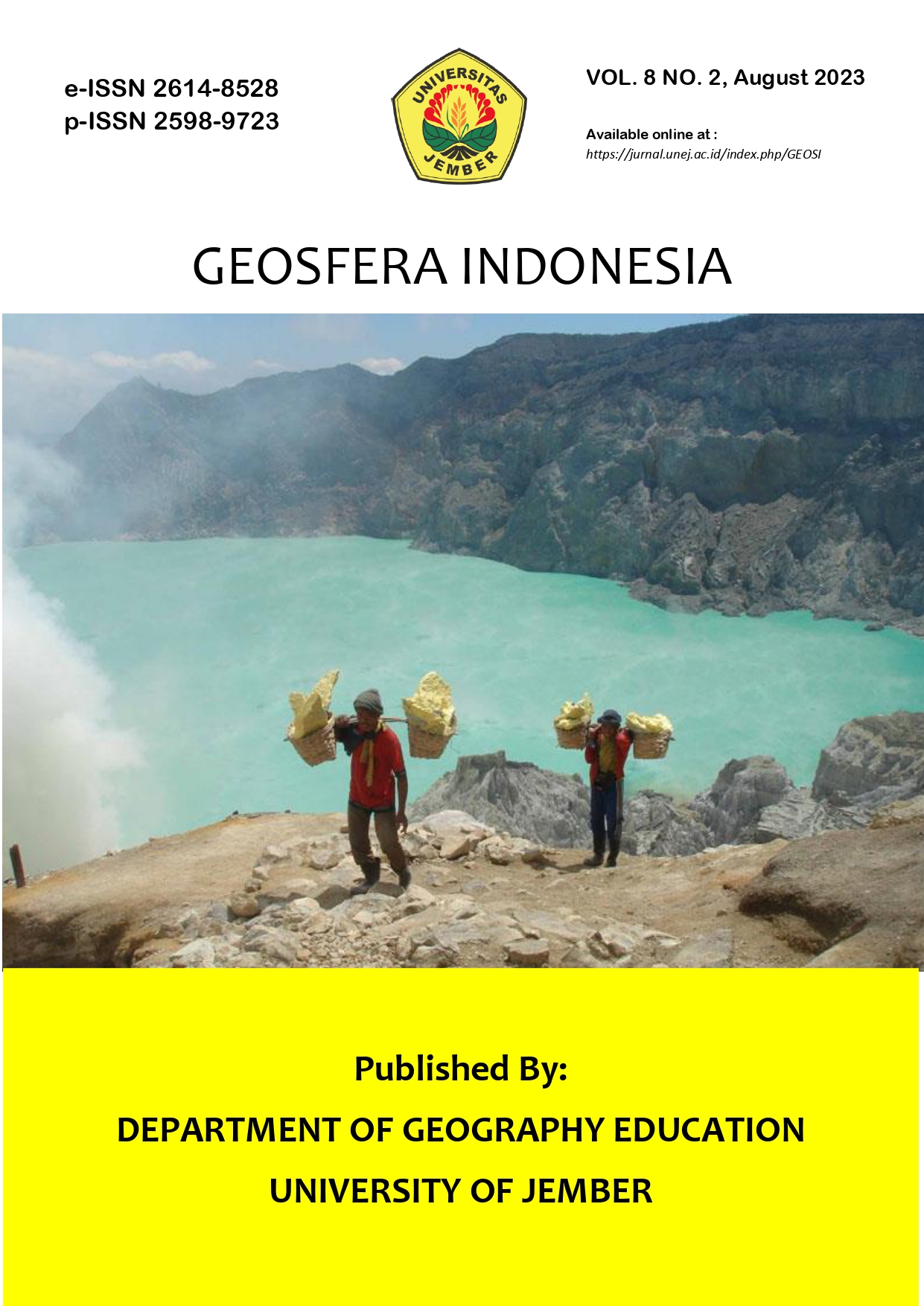Water Balance Assessment, Land Use Land Cover Change and Increasing Water Demand in Three Major Watersheds in Jember, East Java, Indonesia
DOI:
https://doi.org/10.19184/geosi.v8i2.39131Keywords:
Supply, Demand, Water Balance, WEAP, Jember, East JavaAbstract
Jember Regency is the third largest agricultural area in East Java Province. Expansion of built-up and agricultural areas occurred and significantly changed the landscape. Moreover, increasing both types of land cover will increase water consumption. Therefore, there may be changes in the condition of the water balance in the Jember Regency area. This area has three major watersheds: Bedadung, Mayang, and Tanggul. This study evaluated the water balance condition at the three major watersheds in Jember, East Java, Indonesia. The WEAP (Water Evaluation and Planning) model calculated the water balance. Research procedures include (1) inventory of spatial and non-spatial data; (2) setup of the WEAP scheme; (3) Calibration; (4) Validation; and (5) Simulation of water balance model in scenario increasing water demand and land-use change). From 1997 to 2020, the water balance was evaluated using a 10-day interval. The results show that from the November 1st to August 2nd periods, the watershed can supply all demand sites with 100% coverage. However, from August 2nd t to October 3rd periods, the watershed’s ability to supply the water needs decreased. This deficit is due mainly to the uneven rainfall distribution between rainy and dry seasons. Variation in annual rainfall received from 1997 to 2020 also affects the water balance’s surplus and deficit. The fluctuation of land-use change contributed to the surplus and shortage of water balance.
Keywords : Supply; Demand; Water Balance; WEAP; Jember; East Java
Copyright (c) 2023 Geosfera Indonesia and Department of Geography Education, University of Jember

This work is licensed under a Creative Commons Attribution-Share A like 4.0 International License
Downloads
References
Agarwal, S., Patil, J. P., Goyal, V. C., & Singh, A. (2019). Assessment of water supply–demand using water evaluation and planning (WEAP) model for Ur river watershed, Madhya Pradesh, India. Journal of The Institution of Engineers (India): Series A, 100, 21-32. https://doi.org/10.1007/s40030-018-0329-0.
Astuti, I. S., Sahoo, K., Milewski, A., & Mishra, D. R. (2019). Impact of land use land cover (LULC) change on surface runoff in an increasingly urbanized tropical watershed. Water Resources Management, 33, 4087-4103. https://doi.org/10.1007/s11269-019-02320-w.
Awotwi, A., Anornu, G. K., Quaye-Ballard, J. A., Annor, T., Forkuo, E. K., Harris, E., ... & Terlabie, J. L. (2019). Water balance responses to land-use/land-cover changes in the Pra River Basin of Ghana, 1986–2025. Catena, 182, 104129. https://doi.org/10.1016/j.catena.2019.104129.
BPS (2021). Provinsi Jawa Timur dalam Angka 2021. Surabaya: BPS Provinsi Jawa Timur.
BSN (2015). Penyusunan neraca spasial sumber daya alam – Bagian 1 : Sumber daya air.
Carpenter, A., & Choudhary, M. K. (2022). Water demand and supply analysis using WEAP model for Veda river basin Madhya Pradesh (Nimar region), India. Trends in Sciences, 19(6), 3050-3050. https://doi.org/10.48048/tis.2022.3050.
Dinka, M. O., & Chaka, D. D. (2019). Analysis of land use/land cover change in Adei watershed, Central Highlands of Ethiopia. Journal of Water and Land Development, 41. https://doi.org/10.2478/jwld-2019-0038.
Indarto, I., & Hakim, F. L. (2021). Tracking the land use land cover changes from 2000 to 2018 in local area of East Java Province. Bulletin of Geography. Socio-economic Series, 52, 7-24. https://doi.org/10.2478/bog-2021-0010.
Kundu, S., Khare, D., & Mondal, A. (2017). Past, present and future land use changes and their impact on water balance. Journal of environmental management, 197, 582-596. https://doi.org/10.1016/j.jenvman.2017.04.018.
Losiri, C., Nagai, M., Ninsawat, S., & Shrestha, R. P. (2016). Modeling urban expansion in Bangkok metropolitan region using demographic–economic data through cellular automata-Markov chain and multi-layer perceptron-Markov chain models. Sustainability, 8(7), 686. https://doi.org/10.3390/su8070686.
McNamara, I., Nauditt, A., Zambrano-Bigiarini, M., Ribbe, L., & Hann, H. (2021). Modelling water resources for planning irrigation development in drought-prone southern Chile. International Journal of Water Resources Development, 37(5), 793-818. https://doi.org/10.1080/07900627.2020.1768828.
Mourad, K. A., & Alshihabi, O. (2016). Assessment of future Syrian water resources supply and demand by the WEAP model. Hydrological Sciences Journal, 61(2), 393-401. https://doi.org/10.1080/02626667.2014.999779.
Nugroho, P., Marsono, D., Sudira, P., & Suryatmojo, H. (2013). Impact of land-use changes on water balance. Procedia Environmental Sciences, 17, 256-262. https://doi.org/10.1016/j.proenv.2013.02.036.
Setiawan E.B. & Hariyanto B. (2017) Potensi daya dukung air meteorik untuk pemenuhan kebutuhan air domestik masyarakat di Kabupaten Tulungagung. Swara Bhumi, 4(5).
Setiawan, E. B., Indarto, I., & Wahyuningsih, S. (2019). Analisis Neraca Air Pertanian Di Sub Das Rawatamtu (Analysis Of Agricultural Water Balance In Rawatamtu Sub-Watershed). Jurnal Penelitian Pengelolaan Daerah Aliran Sungai (Journal of Watershed Management Research), 3(2), 175-194.
Setiawan, E. B., Indarto, I., Askin, A., & Utami, A. R. (2019). Spatial variability of annual rainfall in East Java Regions: application of histogram and normal QQ-Plot. In IOP Conference Series: Earth and Environmental Science, 243(1). https://doi.org/10.1088/1755-1315/243/1/012027.
Sihombing, A. M. C., Indarto, I., & Wahyuningsih, S. (2021). Assessment of water balance at mayang watershed, East Java. Geosfera Indonesia, 6(1), 55-76. https://doi.org/10.19184/geosi.v6i1.23111.
Slaymane, R.A., & Soliman, M. R. (2022). Integrated water balance and water quality management under future climate change and population growth: a case study of Upper Litani Basin, Lebanon. Climatic Change, 172(3-4), 28. https://doi.org/10.1007/s10584-022-03385-0.
Soewarno S. (2015). Klimatologi Seri Hidrologi. Yogyakarta: Graha Ilmu.
Sujarwo, M. W., Indarto, I., Wiratama, E., & Teguh, B. (2019). Assessment of morphometric and hydrological properties of small watersheds in East Java Regions. Teknik SIpil, 26(2), 97-110.
USCS. (2015). Water Evaluation And Planning System (WEAP). Stockholm Environment Institute, August. pp. 1–202, 2015.
Yao, A. B., Mangoua, O. M. J., Georges, E. S., Kane, A., & Goula, B. T. A. (2021). Using “Water Evaluation and Planningâ€(WEAP) Model to Simulate Water Demand in Lobo Watershed (Central-Western Cote d’Ivoire). J. Water Resour. Prot, 13(3). https://doi.org/ 10.4236/jwarp.2021.133013.



